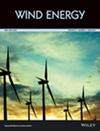海上风电场阻塞效应参数化研究的数值模拟
IF 3.3
3区 工程技术
Q3 ENERGY & FUELS
引用次数: 0
摘要
摘要本文研究了风电场上游对风速的影响,即阻塞效应。采用执行器盘法设计了Reynolds平均Navier-Stokes (RANS)数值模型,并利用Horns Rev 1风电场的SCADA数据进行了验证。SCADA与数值模型的第一行平均功率最大差值为7.8%。利用该模型确定阻塞效应对风电场参数的影响以及风速和发电量的降低程度。定义了一个参考风电场,修改了风电场的尺寸、间距、涡轮机高度和直径,用于与其他风电场的配置进行比较。本文介绍了风电场参数对上游风速降低影响的研究结果。已经确定,将涡轮间距从5D增加到6.7D,可使堵塞造成的功率损失减少2倍。当间距增加两倍时,几乎消除了堵塞损失。同样,风力机推力系数(C T)对堵塞的影响较大,C T越高影响越明显。实际上,堵塞引起的速度亏损与ct成正比。塔架高度对堵塞效果影响较小,在研究范围内,由于堵塞导致的功率降低变化为0.3%。一排涡轮机的数量(一排涡轮机的数量恒定)对堵塞没有显著影响。本文章由计算机程序翻译,如有差异,请以英文原文为准。
Numerical simulations for a parametric study of blockage effect on offshore wind farms
Abstract The paper presents a study of the upstream influence of wind farms on the wind speed, which is called blockage effect. A Reynolds Averaged Navier–Stokes (RANS) numerical model using an actuator disc method was devised and validated using the SCADA data from a Horns Rev 1 wind farm. The maximum difference between the average power in the first row for SCADA and the numerical model was 7.8%. The model was used to determine the impact of blockage effect on the wind farm parameters and the extent to which the wind speed and the power generation were reduced. A reference wind farm was defined, with a modified size, spacing, turbine height, and diameter that were used for comparison with other wind farm configurations. The results of the investigation of the wind farm parameter effects on the upstream wind speed reduction are presented in the paper. It has been established that increasing the turbine spacing from 5D to 6.7D reduces the power loss due to blockage by two. Blockage losses are almost eliminated when the spacing is increased two times. Similarly, the wind turbine thrust coefficient (C T ) has a large impact on blockage, which is more pronounced, when C T is higher. In fact, the velocity deficit due to blockage is proportional to C T . The turbine tower height has small impact on blockage effect—the power reduction was changed by 0.3% due to blockage for the investigated range. The number of turbines in a row (with a constant number of turbines in a row) does not affect blockage significantly.
求助全文
通过发布文献求助,成功后即可免费获取论文全文。
去求助
来源期刊

Wind Energy
工程技术-工程:机械
CiteScore
9.60
自引率
7.30%
发文量
0
审稿时长
6 months
期刊介绍:
Wind Energy offers a major forum for the reporting of advances in this rapidly developing technology with the goal of realising the world-wide potential to harness clean energy from land-based and offshore wind. The journal aims to reach all those with an interest in this field from academic research, industrial development through to applications, including individual wind turbines and components, wind farms and integration of wind power plants. Contributions across the spectrum of scientific and engineering disciplines concerned with the advancement of wind power capture, conversion, integration and utilisation technologies are essential features of the journal.
 求助内容:
求助内容: 应助结果提醒方式:
应助结果提醒方式:


